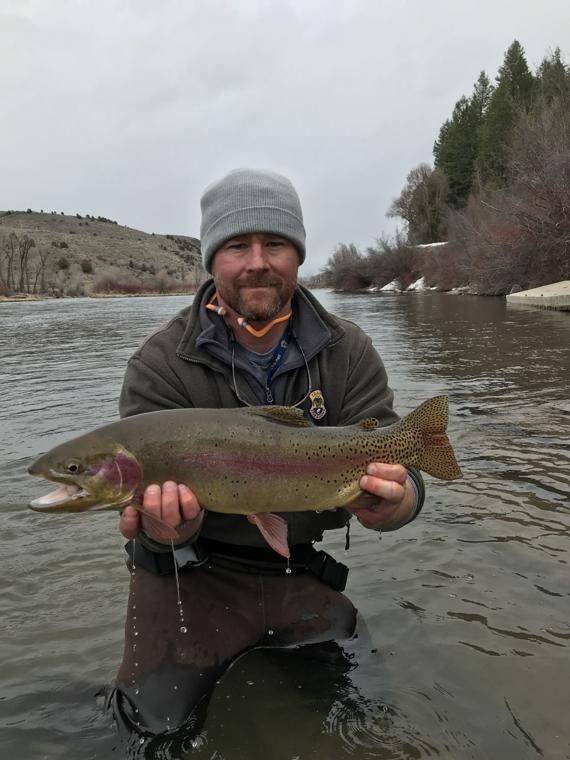The numbers are in, and Idaho Department of Fish and Game zapped nearly 6,000 rainbow trout in the South Fork and dumped them into three area ponds as part of a study to suppress the species.
A total of 5,857 rainbows were removed from the South Fork from three areas known to have high concentrations of rainbows. Becker Pond in Idaho Falls received 1,480 fish, Jim Moore Pond in Roberts got 1,160 fish and Trail Creek Pond near Victor got 2,064 fish — 200 fish died in transport.
The problem Fish and Game faces is trying to manage the river to preserve the native Yellowstone cutthroat trout population, but non-native rainbows are threatening to overwhelm cutthroats and hybridize with natives.
“I think the rainbow trout abundance has doubled since 2002,” said fisheries biologist Pat Kennedy. “I think they’re nearly twice as high as cutthroat abundances right now. That becomes a threat during spawning season when there are more rainbow trout to hybridize with cutthroat trout.”
Fish and Game continues to use its harvest incentive program urging anglers to keep all rainbows and placing bounty tags in the snout of many fish worth as much as $1,000. But anglers often don’t cooperate.
“By and large the angling public doesn’t like to harvest fish,” said James Brower, Fish and Game regional communications manager. “They would have to be harvesting for that to be effective. So that’s why we began this secondary study of our own mechanical suppression as an addition to that. We do wish anglers would be a little more prone to harvest and help that way. It’s crucial to the health of the river. But if people don’t want to do that it’s their choice.”
Kennedy said the electrofishing efforts this spring was to see if it would be a viable option to suppress fish.
“The effort that we provided this year probably wasn’t enough of a suppression effort to benefit the entire Yellowstone cutthroat population in the Snake River South Fork,” Kennedy said. “There may have been local small scale benefits. I think we learned that we can remove enough and over subsequent years if we choose to continue this. I think that we could have a result in enough of a decline in rainbows to benefit the cutthroats.”
Kennedy said removing 5,857 rainbow from the South Fork didn’t make much of a dent in the overall problem.
“Our estimates of rainbow trout is that there are about 90,000 rainbow trout in the South Fork from the (Palisades) dam down to about Byington boat ramp,” he said. “We have a lot of work to do to remove enough rainbow to benefit cutthroat.”
Kennedy admitted that removing rainbows is not always a popular idea with some anglers. Many prize catching the feisty rainbows over more docile cutthroats.
“We certainly are concerned about anglers’ interests and their opinions,” he said. “I think we hear support, we also hear some concern from anglers, some pushback. My opinion is that those are both kind of the polar opposites and the vocal minority on both sides, both for and against what we’re doing.”
Kennedy says he expects Fish and Game to ramp up electrofishing in the coming years to check rainbow numbers and give cutthroat a better chance. Estimates put rainbows at close to twice the number of cutthroats in the South Fork, especially in the Swan Valley area.
He reported that another rainbow suppression program of using weirs on four tributary creeks — Burns Creek, Pine Creek, Rainy Creek and Palisades Creek — of the South Fork has worked well. The weirs capture spawning trout during the spring and rainbows are removed. Cutthroats are tagged and tracked with in-stream monitoring devices and allowed to continue on their way.
“I think we have eliminated that life history that went from the mainstem up into the tributaries to hybridize,” Kennedy said. “We’ve used genetics to monitor the genetic integrity of the Yellowstone cutthroat upstream of those weirs. We have less than 1 percent hybridization with rainbow trout in those populations.”
Another approach Fish and Game hoped to try was called a “spring freshet.” Essentially releasing a blast of water from Palisade Reservoir about the time rainbow trout would spawn and flush their redds (nests) down the river.
“Modeling suggested that we needed 25,000 cubic feet per second out of the dam to achieve that effect,” Kennedy said. “Flood stage is at 22,000 so the reality is that was never going to be a very good tool.”
So it’s likely that come next spring, some area ponds will once again be flooded with hundreds of rainbows taken from the South Fork.
“I think it’s going to be a good thing,” Brower said. “It seems to be a pretty effective way to manage those rainbows on the South Fork.”



